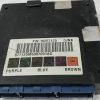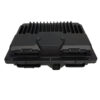Is Your Truck or Van Running Rough? The Solution is Here.
The Powertrain Control Module, or PCM, is the central computer of your vehicle, orchestrating everything from fuel injection and spark timing to transmission shift points and emissions controls. When this critical component begins to fail, it can cause a cascade of frustrating and often misdiagnosed problems. If you’re dealing with unexplained performance issues in your Chevrolet, GMC, or Isuzu vehicle, a failing PCM is a likely culprit.
This isn’t just a replacement part; it’s a complete, plug-and-play solution. We take the guesswork out of the repair by programming this module specifically for your vehicle using the VIN you provide. It arrives loaded with the latest software updates directly from GM, which often correct underlying factory issues and improve overall vehicle operation. This ensures optimal performance and a seamless installation process, getting you back on the road with confidence.
From the Diagnostic Bay
We had a 1999 Chevy S10 with the 4.3L V6 come into the shop with a persistent check engine light and a complaint of sluggish acceleration. The owner had already replaced the MAF sensor and both upstream O2 sensors trying to fix a lean code (P0171). After checking fuel pressure and looking for vacuum leaks, our scan tool showed erratic short-term fuel trim numbers that didn’t correspond with sensor data. We suspected the PCM. After installing one of our pre-programmed modules, the fuel trims stabilized immediately, the code was cleared, and the truck’s power was fully restored. The original PCM’s internal driver for the fuel injectors was failing intermittently, a common issue these modules develop over time.
Common Symptoms of a Failing PCM
- ✔ Check Engine Light is on with various trouble codes, especially communication or internal processor faults.
- ✔ Engine stalling, stumbling, or hesitating for no apparent reason.
- ✔ Noticeable decrease in fuel economy.
- ✔ Harsh or erratic automatic transmission shifting.
- ✔ The vehicle cranks but refuses to start (no-start condition).
- ✔ Misfire codes that persist even after replacing spark plugs, wires, and coils.
- ✔ Failure to communicate with a diagnostic scan tool.
Why Choose Our Pre-Programmed GM PCM 16263494?
Replacing the brain of your vehicle can be an intimidating task. Dealerships often charge a premium for the part and additional fees for programming. Our solution simplifies the entire process. By providing your Vehicle Identification Number (VIN) after your purchase, you receive a module that is precisely calibrated for your truck or van’s specific configuration, including engine size, transmission type, and emissions equipment. This eliminates the need for expensive dealer tools or additional programming appointments. It is a direct-fit, reliable repair that restores your vehicle to its factory-specified operating condition.
Frequently Asked Questions
Do I need to get this module programmed?
No. We handle all the programming for you before shipment. Simply provide us with your vehicle’s VIN after you complete your purchase, and the module will arrive ready to install.
Is this a simple plug-and-play installation?
For most vehicles, yes. After installation, you may need to perform a security relearn procedure, which can typically be done without special tools and involves a sequence of key cycles. Instructions are widely available online for your specific model.
How do I know for sure that my old PCM is the problem?
While the symptoms listed are strong indicators, it’s always best to have a professional diagnosis. A technician can rule out other potential causes like faulty wiring, sensors, or grounds before you replace the PCM. Common diagnostic codes pointing to a bad PCM include P0600-P0606.
Will this part fix my check engine light?
If the check engine light is caused by an internal failure of your existing PCM, then yes, this replacement module will resolve the issue. It’s crucial to ensure the codes are not being caused by other faulty components on the vehicle.
Where is the PCM located on my vehicle?
The location varies. On many GM trucks and SUVs like the S10/Blazer, it’s in the engine bay on the passenger side fender. On Express and Savana vans, it’s often in the LH rear of the engine compartment. On full-size pickups, it’s typically under the hood near the battery. Always disconnect the battery before removal and installation.


